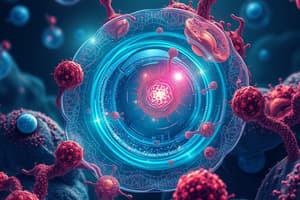Podcast
Questions and Answers
What is the size of a 'typical' vertebrate cell?
What is the size of a 'typical' vertebrate cell?
- 10 μm (correct)
- 0.2 mm
- 1 μm
- 25 nm
What is the size of ribosomes?
What is the size of ribosomes?
- 25 nm (correct)
- 10 μm
- 1 μm
- 0.2 mm
What is the resolution of the light microscope?
What is the resolution of the light microscope?
- 0.2 μm (correct)
- 1 μm
- 25 nm
- 0.2 mm
What method can be used to localize proteins in fixed cells?
What method can be used to localize proteins in fixed cells?
What technique transformed cell biological studies by allowing localization of specific proteins in living cells?
What technique transformed cell biological studies by allowing localization of specific proteins in living cells?
What does TEM allow one to see in cells?
What does TEM allow one to see in cells?
Where is the genetic material (DNA) located in prokaryotes?
Where is the genetic material (DNA) located in prokaryotes?
What encloses the genetic material (DNA) in Eukaryotic cells?
What encloses the genetic material (DNA) in Eukaryotic cells?
What is the function of mitochondria in the cell?
What is the function of mitochondria in the cell?
Where are chloroplasts found?
Where are chloroplasts found?
What do the endoplasmic reticulum and Golgi apparatus have in common?
What do the endoplasmic reticulum and Golgi apparatus have in common?
What accounts for about 50% of the cell volume?
What accounts for about 50% of the cell volume?
What provides a dynamic three-dimensional framework in the cell?
What provides a dynamic three-dimensional framework in the cell?
What do mitochondria and chloroplasts probably evolve from?
What do mitochondria and chloroplasts probably evolve from?
What is the major protein in microtubules?
What is the major protein in microtubules?
What is the function of the plasma membrane in a cell?
What is the function of the plasma membrane in a cell?
Flashcards are hidden until you start studying




